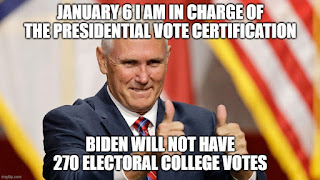When Democrats Failed to Overturn Election the Objections were only "Symbolic," but Things are far different this Time

January 2017, Trump vs Clinton
If the House Democrats gained the support of a single senator, it would have delayed the confirmation of Trump’s victory and the Senate would have went to its chamber to debate the merits of each challenged electoral vote. The 2020 Presidential Election has 5 or more states with legitimate claims that might all be challenged.
Nancy Pelosi said after the disputed Trump vote, “Quite frankly, there’s nothing they could say in there that would be an overstatement of the reasons why we should have a floor discussion. But the fact is you can’t do it on a one-house basis.” She added, "Most of the protest was symbolic." In other words, the Democrats had no evidence to contradict the vote tallies.
Democrats set the Precedent: January 2005
Representative Stephanie Tubbs Jones and Senator Barbara Boxer objected to Ohio’s electoral votes for George W. Bush, alleging “they were not in all known circumstances regularly given.” The House and Senate met separately as required and using a roll call vote the objections were widely rejected. The House denied the objection in 31-267 vote, and the Senate denied it in a 1-74 vote.
2021
There were grumbles, gavel banging and boos during the last January 6th election challenge when the challenges were symbolic. January 6, 2021 will likely be very emotional and chaotic.
The Constitution Center Explains...
Objections to individual state returns must be made in writing by at least one Member each of the Senate and House of Representatives. If an objection meets these requirements, the joint session recesses and the two houses separate and debate the question in their respective chambers for a maximum of two hours,” the CRS said. “The two houses then vote separately to accept or reject the objection. They then reassemble in joint session, and announce the results of their respective votes. An objection to a state’s electoral vote must be approved by both houses in order for any contested votes to be excluded.”
That interpretation applies to two scenarios in the 2020 election. The first is a situation where only one set of electoral votes is submitted by a state, and objections are raised on grounds that electoral votes were not “regularly given” by an elector, or that electors were not “lawfully certified” according to state laws, according the CRS.
The second scenario applies when two or more slates of electors from the same state are submitted to Congress, as was the case for the 1876 presidential election. It is unclear, said the CRS, if Congress could vote to discard a slate of electoral votes certified by a state if it followed its own election laws. “The assumption presented in the law is that only one list would be from electors who were determined to be appointed pursuant to the state election contest statute (as provided for in 3 U.S.C. §5), and that in such case, only those electors should be counted,” the CRS determined.
Regardless, as of December 15, 2020 the first scenario would seem more likely, unless a state legislature decides to send a second slate of electors to Congress and the Archivist by January 6, 2021. By December 9, 2020, all 50 states and the District of Columbia had certified their electoral votes as required by federal law.
Still, questions remain about the Electoral Count Act as a viable long-term solution to the problems it purports to resolve. There are unclear roles of state governors and other state officials as “certifiers” and what role the vice president can play in the process.
Under the federal statute, the vice president’s role is “to preserve order” at the joint meeting. “This authority may be interpreted as encompassing the authority to decide questions of order, but the statute is not explicit on this point,” said the CRS. In past meetings, the vice president has ruled on questions about how the session should be conducted in compliance with federal statutes, which limit motions and almost all debate at the joint session. The vice president is also allowed to call for objections when electoral votes are announced and to state the results of those objections after the House and Senate meet separately to consider them.
Currently, 270 electoral votes are needed to win a presidential election. This presents an open issue if the 270-vote threshold should be lowered if fewer electoral votes are counted.
Others have said that the Electoral Count Act is flawed.
(https://constitutioncenter.org/blog/explaining-how-congress-settles-electoral-college-disputes)
IF neither Candidate reaches 270 Electoral votes:
However, not every member of the House casts a vote. Instead each state gets one vote. So the delegates of each state vote to determine the candidate that will get their state's one vote. In this scenario, Republicans actually have the advantage, because they will likely have the majority in more states than Democrats. Translated, in this scenario Trump wins.
The Bottom Line: Trump's Re-election Bid is still in play.
https://en.wikipedia.org/wiki/Contingent_election#:~:text=A%20candidate%20must%20receive%20an,established%20by%20the%2012th%20Amendment.
https://abc11.com/election-tie-results-2020-president/7669522/



Comments
Post a Comment